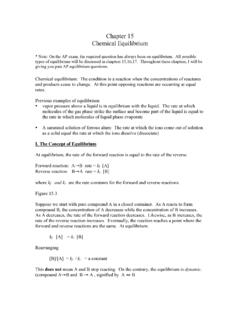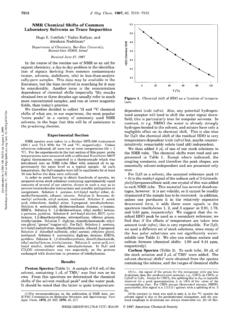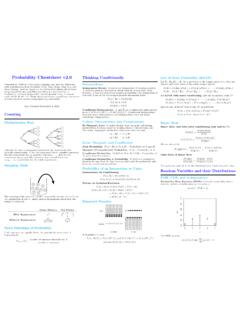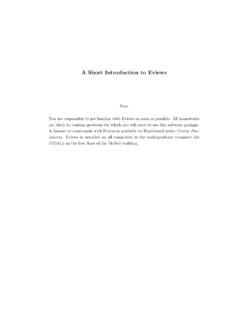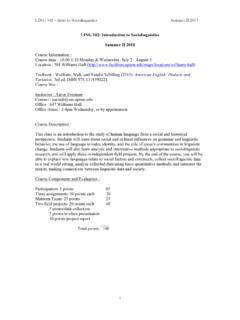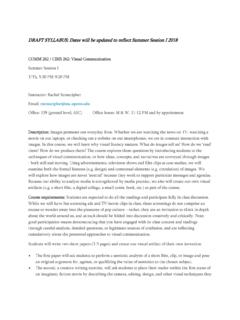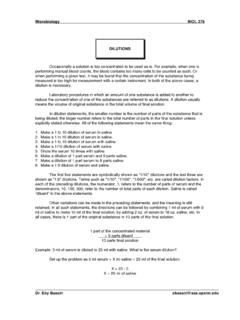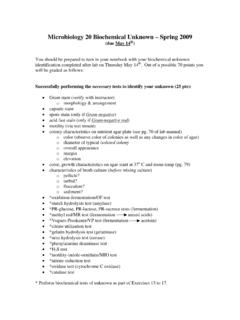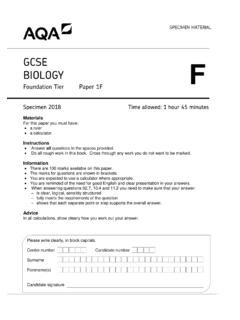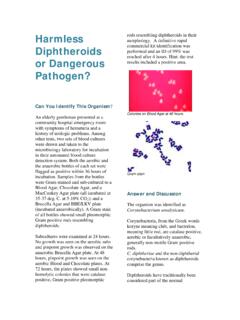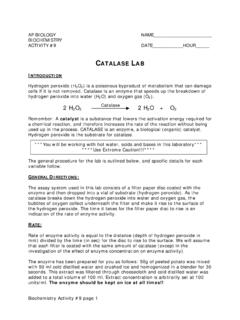Transcription of enzyme final lab
1 Joy Paul enzyme Catalyst lab Abstract: This laboratory explores the affects pH has on a reaction rate. The reaction studied was the breakdown of hydrogen peroxide catalyzed by the enzyme peroxidase. Three trials were run at pH levels of 6, 7 and 8. It was hypothesized that the reaction would run very quickly at a pH of 7, since that is the normal condition of cells where peroxidase is found. It was further hypothesized that the reaction would slow significantly at pH's of 6 and 8 since they are not within the normal pH range of a cell.
2 All hypotheses were found to be correct. Altering the pH of the solution into which the enzyme was added slowed the reaction rates significantly. The breakdown of peroxide occurred most rapidly in the solution with a pH of 7. The slower reaction rates are due to the addition of hydrogen or hydroxide ions which bond to positively or negatively charged side chains of the amino acids within the protein. Since the side chains are bonded to ions in solution, they are unavailable to bond with each other. This lack of bonding amongst the side chains affects the tertiary structure of the protein, changing its shape.
3 The shape change makes many of the peroxidase molecules unavailable to correctly bind with the hydrogen peroxide substrate, thus slowing the rate of the reaction. Materials and Methods: Materials: 9 test tubes 4 small beakers One larger beaker with ice LabPro hardware laptop computer w/ 3 graduated cylinders Disposable pipette Loggerpro software 30 ml H 2 O2. 15 ml each of pH buffer 6, 7,8 enzyme source (ground liver). Methods: 1. Mark the 3 sets of test tubes with a 6, 7 and 8. You should have 3 test tubes of each number (three 6's, three 7's, and three 8's).
4 These numbers represent the pH. of the solution that will be in that tube. 2. Use the graduated cylinder to measure out 3 ml of H 2 O2 . Pour into one of the test tubes. Measure and pour 3 ml of peroxide into each tube. 3. Obtain about 25 ml of enzyme source. Place in a beaker of ice to keep chilled.*We did not do this-a likely source of error discussed below 4. Set up LabPro interface according to the following directions: a. Attach the tubing and stopper to the gas pressure sensor. Plug the sensor into Channel 1 on the LabPro interface, and attach the LabPro to your laptop using the USB cable.
5 Plug in the LabPro to a power source, and start up the LoggerPro software. The software should recognize the sensor and begin taking measurements. 5. Obtain about 15 ml of each pH buffer needed; pH 6, 7 and 8. 6. Using a clean graduated cylinder, measure 3 ml of pH 7 buffer solution. Pour into one of the test tubes marked 7 that contains H 2 O2 . 7. Use a disposable pipette to add 2 drops of enzyme source to the test tube. Place the LabPro stopper into the test tube. Gently swirl the contents of the tube.
6 Immediately hit Start in the LoggerPro software to begin plotting data. 8. Watch the pressure readings on your laptop screen. If the pressure exceeds about 130 kPa, the stopper is likely to pop off the tube. Continue data collection until the rate is no longer linear, the pressure reaches 130 kPa, or about 3 minutes have elapsed (whichever comes first). 9. Send your data to the printer, then clear it. 10. Repeat procedure steps 6-9 with another of the test tubes marked 7 . 11. As a control, run the final test with the pH 7 buffer but do NOT add any enzyme .
7 12. Repeat procedure steps 6-11, replacing the 7 pH buffer with the pH 6 buffer, then the pH 8 buffer. 13. Be sure to print all test results. 14. Clean up all materials before leaving the lab. Results: pH 7: Rate of O2 formation Observations (increase in pressure). Trial 1 w/ enzyme Many bubbles Top popped off .1997 kPa/sec Test tube felt slightly warm Trial 2 with enzyme Very few bubbles No heat generated .02882 kPa/sec Trial 3 no enzyme No bubbles No heat generated x 10 5 kPa/sec pH 6: Rate of O2 formation Observations (increase in pressure).
8 Trial 1 w/ enzyme Some bubbles Test tube felt slightly warm .1485 kPa/sec Trial 2 with enzyme Very few bubbles No heat generated ..05601 kPa/sec Trial 3 no enzyme No bubbles No heat generated kPa/sec pH 8: Rate of O2 formation Observations (increase in pressure). Trial 1 w/ enzyme Very few bubbles Test tube felt slightly warm .01221 kPa/sec Trial 2 with enzyme Very few bubbles No heat generated kPa/sec Trial 3 no enzyme No bubbles No heat generated .002336 kPa/sec Loggerpro generated data tables are attached for review.
9 Rate of oxygen formation was calculated based on the slope of the line as the pressure of oxygen increased within the test tube. The steepest slope, and thus the reaction that had the fastest rate, was the first tube with a pH solution of 7. This tube also had the most visible signs of a reaction taking place such as the formation of many bubbles and the top popping off. The three test trials that were run without enzyme were used as a standard for comparison. Discussion: This lab was run to determine whether pH would affect the rate of an enzyme catalyzed reaction.
10 The reaction in question was the breakdown of hydrogen peroxide catalyzed by the enzyme peroxidase into oxygen and water. Peroxidase is an enzyme normally found in cells. Without it, cells would undergo oxidative damage (Jacobs, 2007). Since the pH of human cells is around 7, I hypothesized that both raising and lowering the pH of the solution would slow the reaction rate. By examining the data, this hypothesis was found to be correct. The rate of reaction, as measured by the rate of oxygen production, was fastest at a pH of 7.
